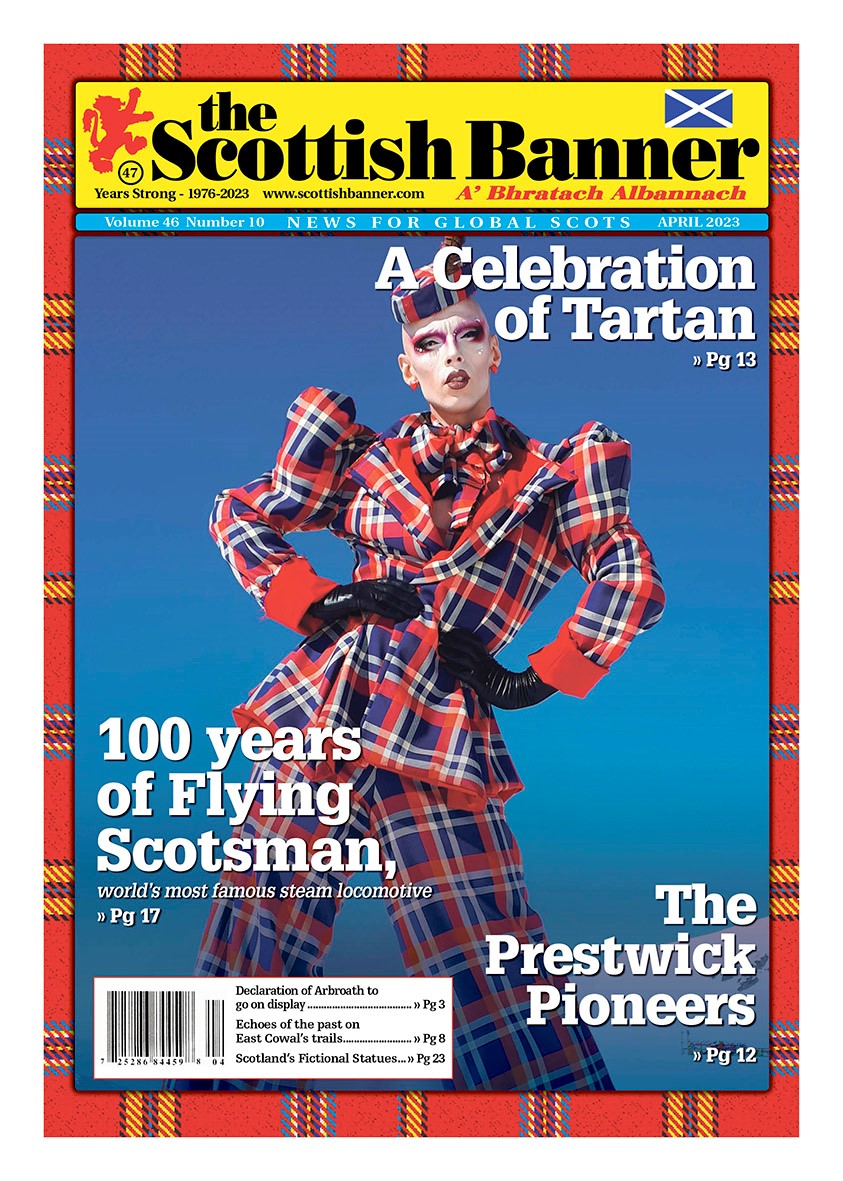April – 2023 (Vol. 46, Number 10)
The Banner Says…
The Cloth of a Nation
When it comes to symbols of Scotland you cannot go past the iconic ‘cloth of a nation’, tartan. Tartan is one of the most recognisable symbols of Scotland and is definitely something which connects people to the nation’s geography, history and heritage. Like the fabric itself, tartan is woven into Scottish identity. It is something that is loved by Scots and all those that wish they were. From heritage regalia, to homewares and high end fashion it is a cloth that never has and never will go out of fashion.
According to the Scottish Register of Tartans a tartan is described as follows: ‘A tartan is a design which is capable of being woven consisting of two or more alternating coloured stripes which combine vertically and horizontally to form a repeated chequered pattern.’
Highland Dress
But just how did tartan come to be and why? Researchers and historians believe tartan, or something similar to what we know of it today, has been woven by Scots for thousands of years. The earliest recorded piece of a tartan like fabric to be found in the UK was in Falkirk, dating back to the 3rd century. This ancient piece of cloth, known as the Falkirk Tartan, was found in a pot and held silver coins. It is considered one of the earliest examples of tartan material in existence and is today housed in the National Museum of Scotland in Edinburgh.
Those early renditions of tartan would not have been linked to Clans or families but would have used the basic colours available found locally and it became especially popular in the Scottish Highlands. By the 16th and 17th centuries weaving wools and dyes was much more common and it became part of Highland dress. On April 16th 1746 at Culloden Moor, just outside of Inverness and in less than an hour, Bonnie Prince Charlie lost the Battle of Culloden and King George II and the Hanoverian government used the opportunity to destroy the perceived military threat of the savage Jacobite Highland clans who supported the return of the Stuart dynasty. The government’s intention was to eliminate the culturally separate identity of the Highland people, and their way of life. The Royal Dress Act of 1746, which was introduced several months after the Battle of Culloden, restricted the wearing of Highland dress. The law would not be repealed until July 1st, 1782.
In this issue
Tartan has now for over 200 years been woven into the fabric of Scottish culture and symbolism. The stunning V&A Dundee this month will launch the much-anticipated exhibition Tartan on Dundee’s renewed waterfront. For Scottish Banner readers the great news is if you happen to be travelling to Scotland this year, or into early next year, you can take in this exhibition of one of the world’s most recognisable textiles and patterns, and the first exhibition in Scotland in 30 years to focus solely on tartan.
Scotland is a great country for taking in local statues. There is always one around with a story to tell. However, we may need to remind ourselves not all statues displayed are in fact a tribute to real people. Fictional characters also get to be remembered across the country from poetry, children’s books and cartoons. Making some of these loved works and characters, adored by generations of people, quite literally set in stone.
The first time I ever flew to Scotland I landed at Glasgow Prestwick Airport. As a young child it was all so exciting to be somewhere new and coming into land over the green Ayrshire countryside. Glasgow Prestwick has a huge history with Scottish aviation and whilst the airport today is not the gateway and transatlantic hub it once was, the Scottish aviators that used Prestwick made their mark on the industry at both home and beyond.
Tartan Day
For hundreds of years people have been able to freely wear tartan across Scotland and a tartan industry has flourished (said to be worth over £350 million a year). There are now thousands of registered tartans which cover everything from personal, company, clan, milestones and more. Tartans are available in a plethora of colours and styles from kilts to carpets. I suspect many Scottish Banner readers will own some tartan and likely in their family or Clan colours. Tartan is loved by both Scots and non-Scots, making it an international timeless fashion statement.
This month across North America Tartan Day will be celebrated on April 6th (in Australia and New Zealand International Tartan Day takes place on July 1st, which marks the anniversary of the repeal of the 1746 Act of Proscription that banned the wearing of tartan). The day started in Nova Scotia, Canada by a reader of the Scottish Banner and has grown into a huge continental celebration and is recognised by governments across Canada, the US and Scotland itself. I hope those who are attending the many events taking place have a wonderful time and proudly wear their tartan as it, like Scots themselves, will never go out of style.
Do you wear or have a favourite tartan? What does tartan mean to you? Do you have you any comments from the content in this month’s edition? Share your story with us by email, post, social media or at: www.scottishbanner.com/contact-us
#ScottishBanner, #TheBanner
The Scottish Banner is more reliant than ever on our readers helping us to provide you with our unique content by buying a copy of our publication, regardless if by print or digital subscription or at a retail outlet.
We appreciate your support and hope you enjoy this edition.

